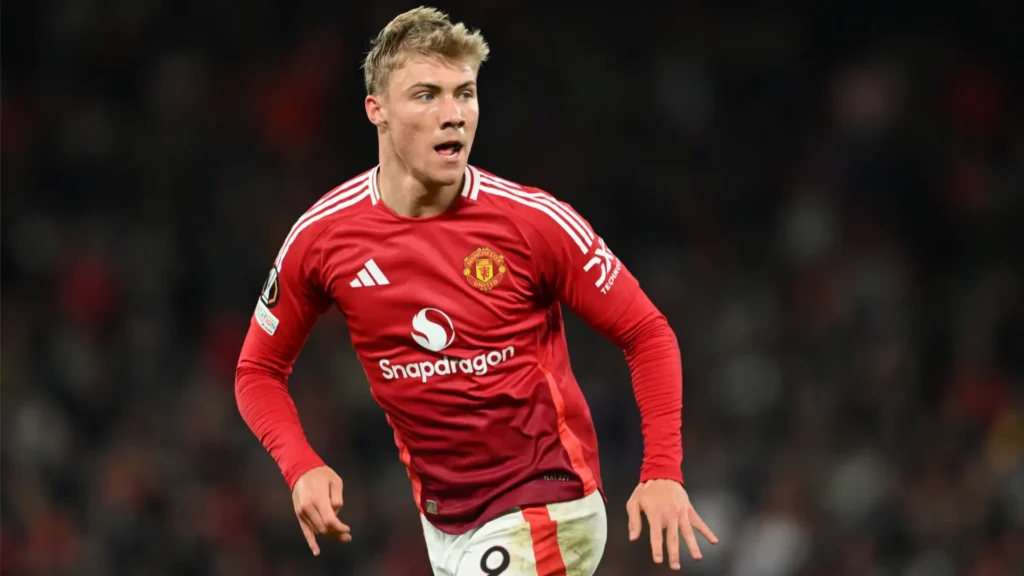
The struggle of center-forwards at Manchester United has been persistent, but the conversation always seems to blame the strikers themselves. The truth, however, is now laid bare by an undeniable piece of evidence: Rasmus Højlund’s success at Napoli.
Many people didn’t realize that Højlund’s struggles at Manchester United were fundamentally linked to Bruno Fernandes’s game. It’s a structural incompatibility that has sabotaged every classic No. 9 the club has signed.
Control group established
Højlund’s immediate, phenomenal impact since moving to Napoli is the smoking gun. Playing with Kevin De Bruyne – a player defined by his technical precision, tactical awareness, and weighted delivery – Højlund is now scoring consistently.
This situation perfectly highlights the difference between a high-volume player and a high-quality facilitator. De Bruyne provides the timely, simple, and perfectly weighted service a positional striker needs to thrive. This confirms that Højlund is an elite striker; his failure at United was entirely systemic.
Bruno as a central midfielder
The biggest error in the current United setup is the insistence on deploying Bruno Fernandes as a Central Midfielder (CM) or an 8.
While Bruno’s raw statistics – touches, shots, and key passes – look impressive on paper, this often leads to a misdiagnosis. He frequently tops the league in “Chances Created,” but if you look closer, the issue is not the quantity of creation, but the quality, context, and structural cost of his delivery.
When playing deep, Bruno’s natural tendencies become catastrophic for the team’s stability:
- Tactical Indiscipline: As a CM, he must maintain position and control the tempo. Instead, Bruno roams, vacating his defensive position and forcing the defensive midfielder (Casemiro or Mainoo) to cover enormous gaps, thus destabilizing the entire spine of the team.
- Lack of Technical Precision: Deeper in the pitch, a CM needs quick, technical passing to break defensive lines cleanly. Bruno tends to bypass the midfield entirely with speculative, long-range passes. These balls are low-percentage and often force the striker (Højlund) to battle defenders in chaotic, low-conversion situations rather than receiving a clean through-ball in space.
- Chaotic Output: His creative passes are often forced, prioritizing the flashy over the functional. This high-risk approach generates high-volume stats but results in chances that are difficult to convert, robbing the team of possession and momentum.
The vicious cycle of misguided support
This structural problem explains why Ronaldo, Lukaku, Cavani, and Højlund all struggled. They are all positional strikers who require the ball delivered with precision into the box.
When the ball gets to the final third, United’s wide players and secondary midfielders are also more interested in scoring themselves than creating chances for the No. 9. This means Bruno feels compelled to take on 90% of the creative burden, leading him to attempt the same low-percentage, high-risk passes that break down the attack.
When Bruno came to United, his numbers looked good, but that was largely because of players like Rashford and Martial. These are not classic strikers; they thrive by creating for themselves from wide positions. They didn’t need perfect assists; they could turn half-chances into goals. That made Bruno look better than he actually was – a successful facilitator for individual brilliance, but not for a systemized center-forward.
Until Bruno is either moved back to a pure attacking role with structural discipline imposed around him or until the team relies on a different, more technically controlled deep playmaker, any classic striker United signs will continue to flop.
Related Opinions
The 151.51 Odds 'Multi-Score' Sunday Games
My Week 1-7 Dec 200 Odds Predictions
The 5 Qualities That Define A True World Class Footballer
EPL Match Day 8 Review: A Wild Weekend of Upsets and Stat...
Facebook Comments
If you have a Facebook, you can easily drop your comment on this opinion
About Author


